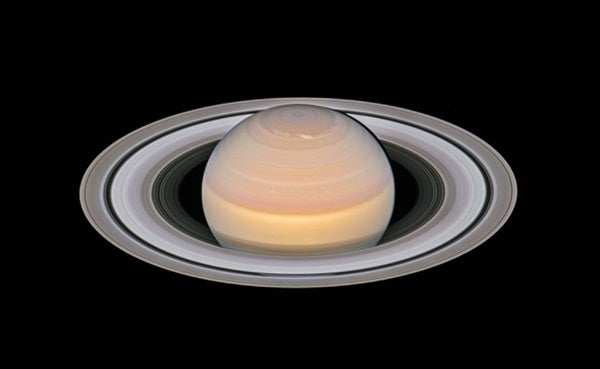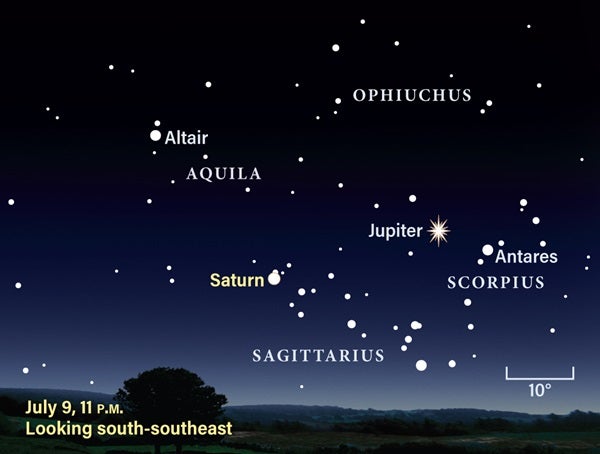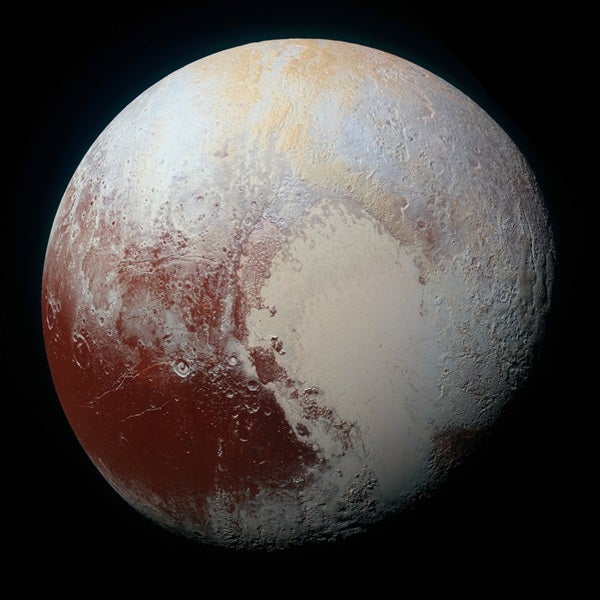Jupiter reached opposition and peak visibility nearly a month ago, but it remains a stunning sight from shortly after sunset until morning twilight starts to paint the sky. It resides among the background stars of southern Ophiuchus the Serpent-bearer, a region that climbs highest in the south around 11 p.m. local daylight time. Shining at magnitude –2.5, Jupiter is the night sky’s most conspicuous object with the exception of the Moon. When viewed through a telescope, the planet’s disk spans 45″ and shows striking cloud-top detail.
The Moon reaches perigee, the closest point in its orbit around Earth, at 1:00 a.m. EDT. It then lies 226,009 miles (363,726 kilometers) away from us.
Saturday, July 6
Observers of the outer solar system can get a good view of Uranus before dawn. The best time to look for it is shortly before twilight begins around 3:30 a.m. local daylight time. Uranus then lies 20° above the eastern horizon among the background stars of southern Aries the Ram. This morning, use binoculars to find the magnitude 5.8 planet 2.3° south of the magnitude 5.7 star 19 Arietis. A telescope reveals Uranus’ blue-green disk, which spans 3.5″.
Sunday, July 7
Tonight offers a nice opportunity for binocular users to track down one of summer’s finest open star clusters. NGC 6231 lies in the tail of Scorpius the Scorpion, just 0.5° north of the double star Zeta (ζ) Scorpii (which is another fine binocular sight). NGC 6231 shines at magnitude 2.6 and packs more than 100 stars into a region just 14′ in diameter, just half the size of the Full Moon. This part of Scorpius lies nearly due south around 11 p.m. local daylight time, though it doesn’t climb high from mid-northern latitudes.
Monday, July 8
The dwarf planet Ceres appears highest in the south as darkness falls and makes a tempting target during the early evening hours. Glowing at 8th magnitude, it’s easy to find through binoculars or a telescope among the bright stars near the border between Scorpius and Libra. The best way to find it is to star-hop from the lovely 2nd-magnitude double star Beta (β) Scorpii. Tonight, Ceres lies 2.7° west-northwest of this star.
Saturn lies opposite the Sun in our sky today, reaching its peak visibility for 2019. The ringed world appears low in the southeast as darkness falls and climbs higher as the evening wears on. It stands about one-third of the way to the zenith in the southern sky around 1 a.m. local daylight time. Saturn shines at magnitude 0.1 against the background stars of northern Sagittarius. When viewed through a telescope this week, the planet shows an 18″-diameter disk surrounded by a dramatic ring system that spans 42″ and tilts 24° to our line of sight. You should also see a handful of moons, led by 8th-magnitude Titan and three 10th-magnitude satellites: Tethys, Dione, and Rhea. Look more carefully and you might pick up the glow from 10th-magnitude Iapetus, which lies quite a bit farther from Saturn. Tonight, it conveniently lines up with Titan, standing 8.4′ west of the planet, or some 2.7 times farther away than its brighter sibling.
The First Quarter Moon lies high above the southwestern horizon as darkness falls. Our satellite officially reaches First Quarter phase at 6:55 a.m. EDT, so it appears a little more than half-lit in this evening’s sky. You can find it among the background stars of Virgo the Maiden, about one binocular field to the upper left of 1st-magnitude Spica.
Wednesday, July 10
The Big Dipper’s familiar shape lies high in the northwest as darkness falls these July evenings. One of the summer sky’s finest binocular double stars marks the bend of the dipper’s handle. Mizar shines at 2nd magnitude, some six times brighter than its 4th-magnitude companion, Alcor. Even though these two are not physically related, they make a fine sight through binoculars. (People with good eyesight often can split the pair without optical aid.) A small telescope reveals Mizar itself as double — and these components do orbit each other.
Thursday, July 11
The Sun’s outermost major planet, Neptune, now rises before midnight local daylight time. But the best time to look for this ice giant world comes when it climbs about 40° high in the southeast as morning twilight commences. The magnitude 7.9 planet lies in Aquarius, 1.2° east-northeast of 4th-magnitude Phi (φ) Aquarii. You can confirm your sighting of Neptune through a telescope, which reveals the planet’s 2.3″-diameter disk and blue-gray color.
Friday, July 12
The Southern Delta Aquarid meteor shower gets underway this week. Although the shower doesn’t peak until the end of July, you should start to see some meteors in the hours before dawn. The best time to look is between 2 and 4 a.m. local daylight time, after the Moon has set and before twilight intrudes. To tell a Southern Delta Aquarid meteor from a random dust particle burning up in Earth’s atmosphere, trace the streak of light’s path backward. A shower meteor will appear to originate from the constellation Aquarius the Water-bearer.
Saturday, July 13
The waxing gibbous Moon passes near Jupiter tonight. From North America, the two were closest this afternoon (when they were below the horizon), though they remain within 5° of each other after darkness falls. Despite Luna’s brilliance dominating the scene, you should have little trouble picking out the magnitude –2.5 planet to its right.
Today marks the peak of Pluto’s 2019 appearance. The distant world reaches opposition, which means it lies opposite the Sun in our sky and remains visible all night. It glows dimly at 14th magnitude, however, so you’ll need an 8-inch or larger telescope with good optics to spot it visually. Pluto currently lies in northeastern Sagittarius, some 1.9° northwest of the 6th-magnitude star 53 Sagittarii.












